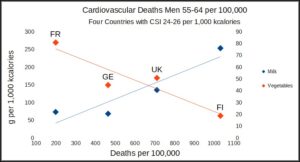The French Paradox – The Myths
‘Everyone knows’ about the French Paradox – that is, the French consume lots of saturated fat in the form of meat, butter, cheese and eggs and yet have a low risk of heart disease. This proves that the health advice regarding the role of fats and saturated fats in causing heart disease is wrong.
The French Paradox has only been with us for a short period of time but it quickly resonated with the general population – we no longer need to be concerned about the amount of meat, butter, cheese and eggs that we consume.
In 1992, when the Frenchmen, Serge Renaud and Michael de Lorgeril published the article Wine, alcohol, platelets, and the French paradox for coronary heart disease that propelled the concept of the French Paradox onto a receptive public. It was not the first time that the phrase was used but The Lancet gave the phrase credibility. 1
The article’s conclusion was:
The Myth
In 2008, the journal, Dialogues in Cardiovascular Medicine, devoted a 76 page issue addressing the history and myths of the French Paradox. 2
The conclusion of this investigation is:
Differences in coronary mortality in 40 Countries
Artaud-Wild et al (1993), using data from 40 countries, 3 showed a strong correlation of 76% with the Cholesterol-Saturated Fat Index (CSI) per 1000 kcalories per day with heart disease in men aged 55 to 64 years. 4 Even though Artaud-Wild is the lead author of this paper, it is known as the Connor study with William and Sonja Connor being two of the contributors. 5
However, France and Finland were outliers in this correlation with Finland having a higher than expected death rate and France a lower rate.
The relationship with heart disease and milk intake showed the same correlation to the CSI but France and Finland were no longer outliers.
The Finnish population consumes 3.5 times more milk than than the French, and the French consume 4 times more vegetables, measured in grams per 1000 kcalories. The French also consume less food. Note that the items are measured per 1000 kcalories. The total amount consumed during the day is more significant.
| Food Item | Units | France | West Germany | United Kingdom | Finland | Finland / France |
|---|---|---|---|---|---|---|
| CHD Mortality | per 100,000 | 198 | 463 | 710 | 1031 | 5.2 |
| CSI | CSI/1000 kcal | 24 | 24 | 24 | 26 | 1.1 |
| Milk | g/1000 kcal | 74 | 69 | 136 | 254 | 3.4 |
| Vegetable Oils | g/1000 kcal | 8 | 4 | 5 | 1 | 0.13 |
| Vegetables | g/1000 kcal | 81 | 45 | 51 | 19 | 0.23 |
Food Intakes of Countries with Similar Cholesterol-Saturated Fat Intake

This study also showed strong correlations with heart disease and a number of dietary components.
| Food item | Units | Correlation |
|---|---|---|
| Calories from animal food | Calories | 79% |
| Cholesterol Saturated Fat Intake | CSI / 1000 kcal | 78% |
| Saturated fat | % kcal | 77% |
| Milk | g / 1000 kcal | 76% |
| Cholesterol | g / 1000 kcal | 69% |
| Calories from vegetable foods | g / 1000 kcal | -80% |
| Starch | g / 1000 kcal | -69% |
Correlations with heart disease mortality and food components
The conclusions of the Connor study are,
The Connor Study dismisses the claims that the French or Finns are different from other countries when considering the role of diet and its impact on heart disease.
French Regional Differences
For many countries, speaking of one national diet is meaningless. There are strong regional variations in diet and disease patterns in France. A north-south-east gradient exists for all-cause mortality, cardiovascular mortality, hypertension, obesity and high lipids. 6
A study involving French women born between 1925 and 1950 showed that the north has a greater consumption of: fat products, butter, margarine, potatoes, processed meat, alcohol, coffee and saturated fats; and has a lower consumption of fibre than the rest of France. 7
Related articles
Do Vegetarians Live Longer
The French Paradox – The Myths
Last updated on Tuesday 22 October 2024 at 12:36 by administrators
Footnotes
- Renaud, S. de & de Lorgeril, M. (1992) Wine, alcohol, platelets, and the French paradox for coronary heart disease. The Lancet. 339 (8808), 1523–1526.
- Tunstall-Pedoe, H. (2008). The French Paradox: Fact or Fiction? Dialogues in Cardiovascular Medicine, 13(3), 159–179.
- Austria, Belgium, Denmark, Finland, France, Hungary, Ireland, Netherlands, Norway, Poland, Sweden, Switzerland, United Kingdom, West Germany, Bulgaria, Egypt, Greece, Israel, Italy, Portugal, Romania, Spain, Yugoslavia, Canada, United States, Argentina, Chile, Costa Rica, Cuba, Dominican Republic, Ecuador, Mexico, Nicaragua, Paraguay, Uruguay, Venezuela, Australia, New Zealand, Hong Kong, Japan
- CSI = 1.01 * g saturated fat + 0.05 * mg cholesterol
- Artaud-Wild, S. M., Connor, S. L., Sexton, G., & Connor, W. E. (1993). Differences in coronary mortality can be explained by differences in cholesterol and saturated fat intakes in 40 countries but not in France and Finland. A paradox. Circulation, 88(6), 2771–2779.
- Cottel, D. et al. (2000) The North–East–South gradient of coronary heart disease mortality and case fatality rates in France is consistent with a similar gradient in risk factor clusters. European Journal of Epidemiology. 16 (4), 317–322.
- Kesse, E. et al. (2005) Regional dietary habits of French women born between 1925 and 1950. European Journal of Nutrition. 44 (5), 285–292.





